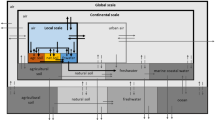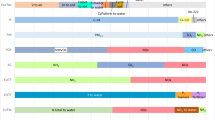Abstract
The absence of spatial and temporal information in the data from a typical Life Cycle Inventory puts constraints on the possibilities of subsequent Life Cycle Impact Assessment to predict actual impact. Usual methods for Life Cycle Impact Assessment (often referred to as “less is better” methods) make only limited use of spatial and temporal information, because they predict concentration increases rather than full concentrations. As a consequence it does not seem possible to evaluate whether a threshold value is surpassed. The resulting poor accordance between the predicted impact and the expected occurrence of actual impact is a major problem. This problem is particularly relevant for human toxicity assessment, since the probability of surpassing thresholds here traditionally is the main point of attention. A considerable group of practitioners suggests to follow an “only above threshold” principle by introduction of assessment tools from risk assessment and environmental impact assessment in LCA. Intensive debate is going on about possibilities and limitations of “less is better” and “only above threshold”. The debate is obscured by two underlying discussions (about no-effect-levels and about data-availability) that are partly, but not fully intertwined. Both principles tend to be given fixed positions in these discussions, and are therefore often put forward as fundamentally different and incompatible with each other. This article entwines the discussions, shows parallels between both principles, and uses these parallels to present a new method for Life Cycle Impact Assessment of human toxicity from air emissions that — with limited data requirement from Life Cycle Inventory — can take as well threshold evaluation and spatial source-differentiation into account.
Similar content being viewed by others
References
Barnthouse, L., J. Fava, K. Humprheys, R. Hunt, L. Laibson, S. Noesen, J. Owens, J. Todd, B. Vigon, K. Weitz andJ. Young (1997): Life-cycle impact assessment. State-of-the-art. United States of America, Pensacola, SETAC-USA
Consoli, F., D. Allen, I. Boustead, J. Fava, W. Franklin, A.A. Jensen, N. de Oude, R. Parrish, D. Postlethwaite, B. Quay, J. Si’guin andB. Vigon (Eds.) (1993): Guidelines for life-cycle assessment. A code of practice. Belgium, Brussels, SETAC-Europe and SETAC-USA
Cowan, C.E., D. Mackay, T.C.J. Feijtel, D. Van de Meent, A. Di Guardo J. Davies andN. Mackay (Eds.) (1995): The multimedia fate model: A vital tool for predicting the fate of chemicals. SETAC PRESS, Pensacola, Florida
Draaijers, G.P.J., J.J.M. Berdowski, H. Leneman, G.A. Rood, D.J. de Vries andE.A. Zonneveld (1994): Emission in The Netherlands, trends, themes and target groups. 1995 and estimates of 1996 (in Dutch). The Netherlands, The Hague, ministry of Housing, Spatial Planning and the Environment (VROM)
Fava, J., F. Consoli, R. Denison, K. Dickson, T. Mohin andB. Vigon (eds.) (1993): A conceptual framework for life-cycle impact assessment. Belgium, Brussels, SETAC-Europe and SETAC-USA
ExternE (1995): Externalities of energy. Volume 2: Methodology. EUR 16521 EN. Luxembourg, European Community
Guinée, J., R. Heijungs, L. Van Oers, D. Van de Meent, T. Vermeire, M. Rikken (1996): LCA impact assessment of toxic releases. Generic modelling of fate, exposure and effect for ecosystems and human beings with data for 100 chemicals. The Netherlands, Leiden, Centre of Environmental Science of Leiden University
Gustafsson, H. (1992): Building materials identified as major sources for indoor air pollutants. A critical review of case studies. Document D10: 1992. Sweden, Boras, Swedish council for building research
Habersatter, K. (1991): Oekobilanz von Packstoffen. Stand 1990. Switzerland, Bern, BUWAL
Hauschild, M. andWenzel, H. (1997): Environmental assessment of industrial products. Vol. 2: Scientific background. Chapman and Hall, United Kingdom
Heijungs, R., J. Guinée, G. Huppes, R.M. Lankreijer, H.A. Udo de Haes, A. Wegener Sleeswijk, A.M.M. Ansems, P.G. Eggels, R. Van Duin andH.P. de Goede (1992): Environmental life cycle assessment of products. Guide and background, The Netherlands, Leiden, Centre of Environmental Science of Leiden University
Hogan, L.M., R.T. Beal andG. Hunt (1996): Threshold inventory interpretation methodology. A case study of three juice container systems. Int. J. LCA, vol. 1, issue 3, p. 159–167
ISO/TC207/SC5N77 (1996): Environmental management — life cycle assessment — principles and framework. Reconstructed draft 14040. Le comité membre français AFNOR of ISO
Jolliet, O. andP. Crettaz (1996): Calculation of fate and exposure coefficients for life cycle toxicity assessment; second draft. Switzerland, Lausanne, Institute of Soil and Water Management from the Swiss Federal Institute of Technology
Kilde, N. (1995): Energy consumption and emissions in transport of products in 1990 (in Danish). Denmark, Roskilde, Forsknings-center Risø
Klaassen, C.D., M.O. Amdur andJ. Doull (1986): Casarett and Doull’s toxicology. The basic science of poisons. Third edition. New York, Macmillam Publishing Company
Lindfors, L.-G., K. Christiansen, L. Hoffman, Y. Virtanen, V. Juntilla, O.-J. Hanssen, A. Rønning, T. Ekval andG. Finnveden (1995): Nordic Guidelines on life-cycle assessment. Nord 1995; 20. Denmark, Copenhagen, Nordic Council of Ministers
Olsen, S.I. (1997): Life-cycle assessment of basic chemicals. PhD-thesis. Denmark, Lyngby, Institute of Manufacturing Engineering
Potting J. andK. Blok (1994): Spatial aspects of life-cycle impact assessment. In: Integrating impact assessment into LCA. Proceedings of the LCA symposium held at the fourth SETAC-Europe Congress, 11-14 April 1994 at the Free University of Brussels in Belgium. Belgium, Brussels, SETAC-Europe
Potting, J. andM. Hauschild (1997): Predicted Environmental impact and expected occurrence of actual environmental impact. Part 1: The linear nature of environmental impact from emissions in life-cycle assessment.Int. J. LCA, Vol. 2, Issue 3, p. 171–177
Rabl, A. andJ.V. Spadaro (1998): Estimates of real damage from air pollution: Site dependency and simple impact indices for LCA. Contribution to the 8th annual meeting of SETAC-Europe, 14-18 April 1998 in Bourdeaux, France. France, Paris, Ecole de Mines de Paris
Toppari, J., J.C. Larsen, P. Christiansen, A. Giwercman, P. Grandjean, L.J. Guillette, B. Jégou, T.K. Jensen, P. Jouannet, N. Keiding, H. Leffers, J.A. McLachlan, O. Meyer, J. Müller, E. Rajpert-DeMeyts, T. Scheike, R. Shapre, J. Sumpter andN.E. Skakkebæk (1995): Male reproductive health and environmental chemicals with estrogenic effects. Miljøprojekt nr. 290. Denmark, Copenhagen, Danish EPA
Tukker, A. (1997): Combining SFA and LCA: The Swedish PVC Analysis. Proceedings of the fifth LCA case studies symposium, 2 December in Brussels. Belgium, Brussels, SETAC-Europe
Udo de Haes, H.A. (ed.) (1996): Towards a methodology for life-cycle impact assessment. Belgium, Brussels, SETAC-Europe
Wenzel, H., M. Hauschild andL. Alting (1997): Environmental assessment of industrial products. Vol. 1: Methodology, tools and case studies in product development. Chapman and Hall, United Kingdom
White, P., B. De Smet, H.A. Udo de Haes, R. Heijungs (1995): LCA back on track, but is it one track or two? LCA news from SETAC-Europe, vol. 5, issue 3, p. 2–5
Williams, M. (Ed.) (s.d.): Exposure assessment. Report number 1. Cost 613/2 Report series on air pollution epidemiology. Directorate-General XII for Science, Research and Development from the Commission of the European Communities
Author information
Authors and Affiliations
Corresponding author
Rights and permissions
About this article
Cite this article
Potting, J., Hauschild, M. & Wenzel, H. “Less is better” and “only above threshold”: Two incompatible paradigms for human toxicity in life cycle assessment?. Int. J. LCA 4, 16–24 (1999). https://doi.org/10.1007/BF02979391
Issue Date:
DOI: https://doi.org/10.1007/BF02979391




